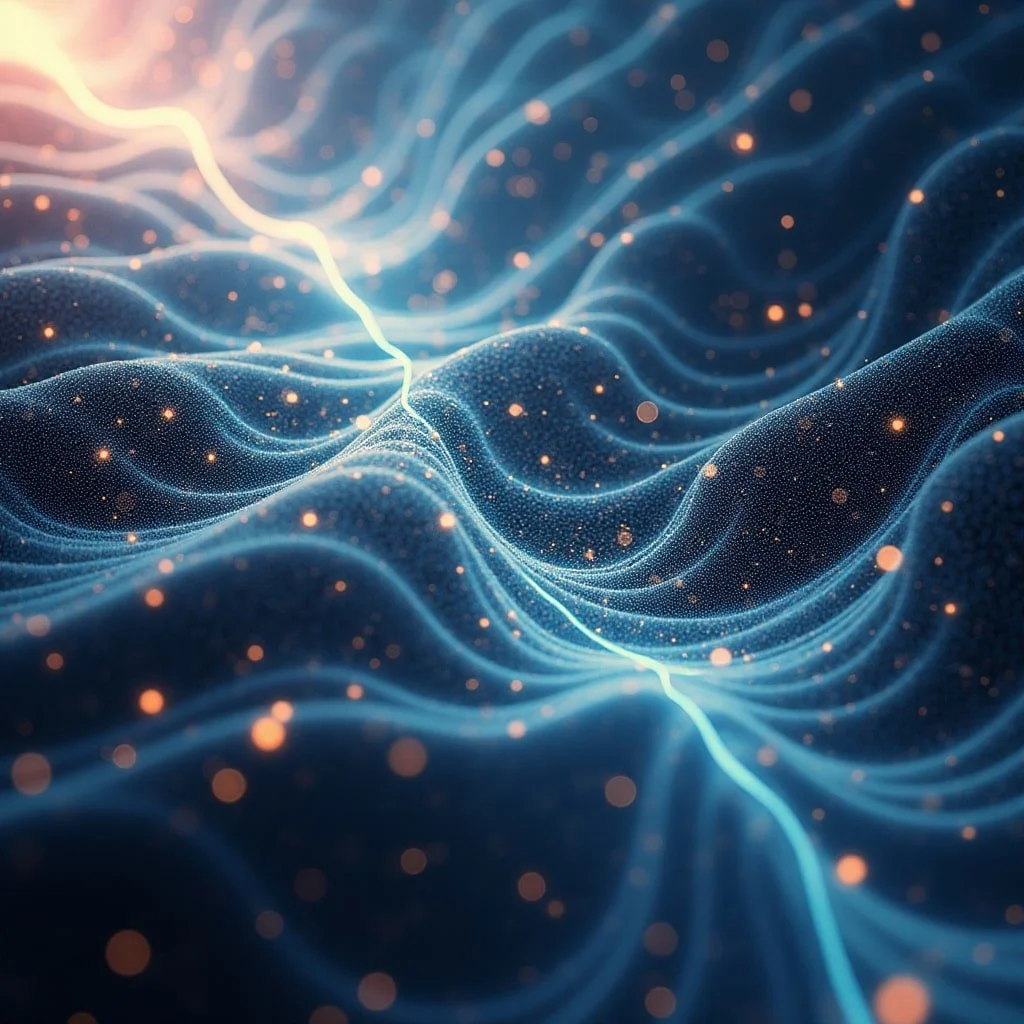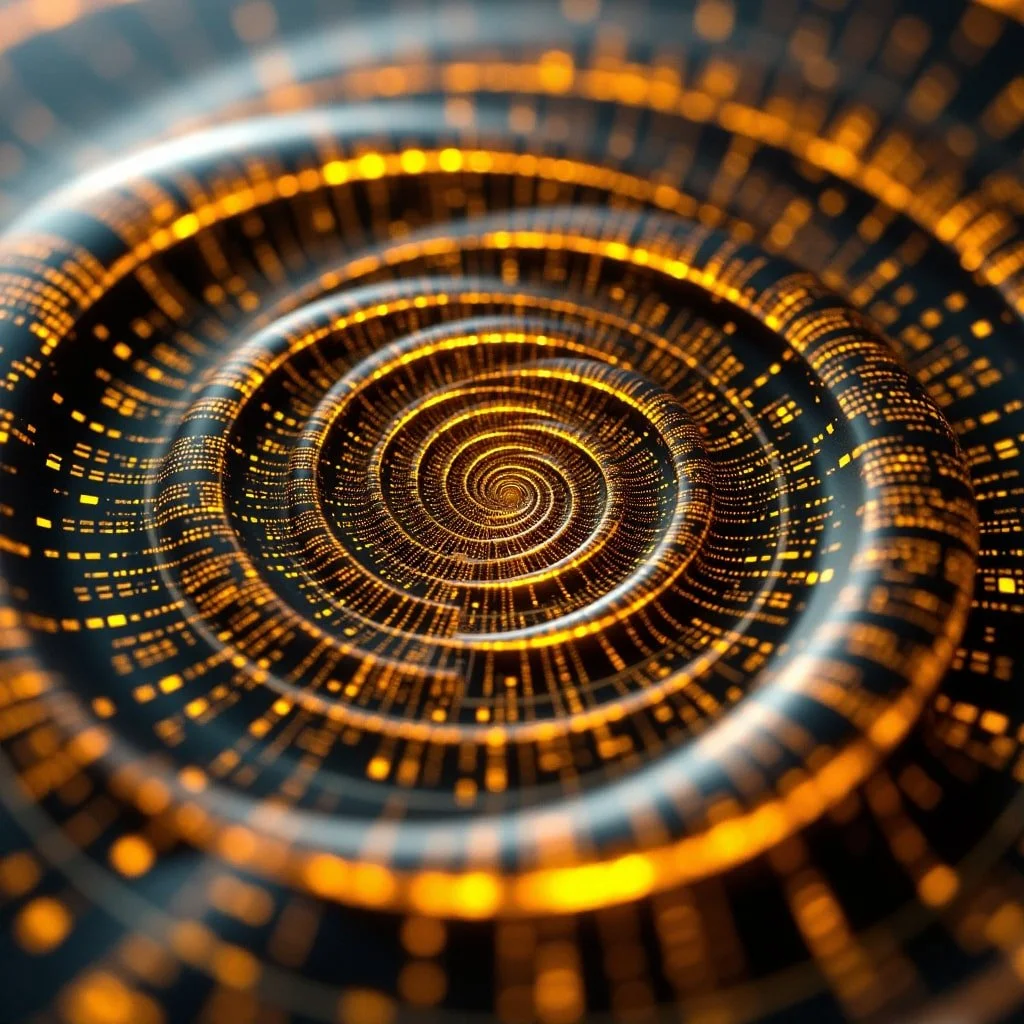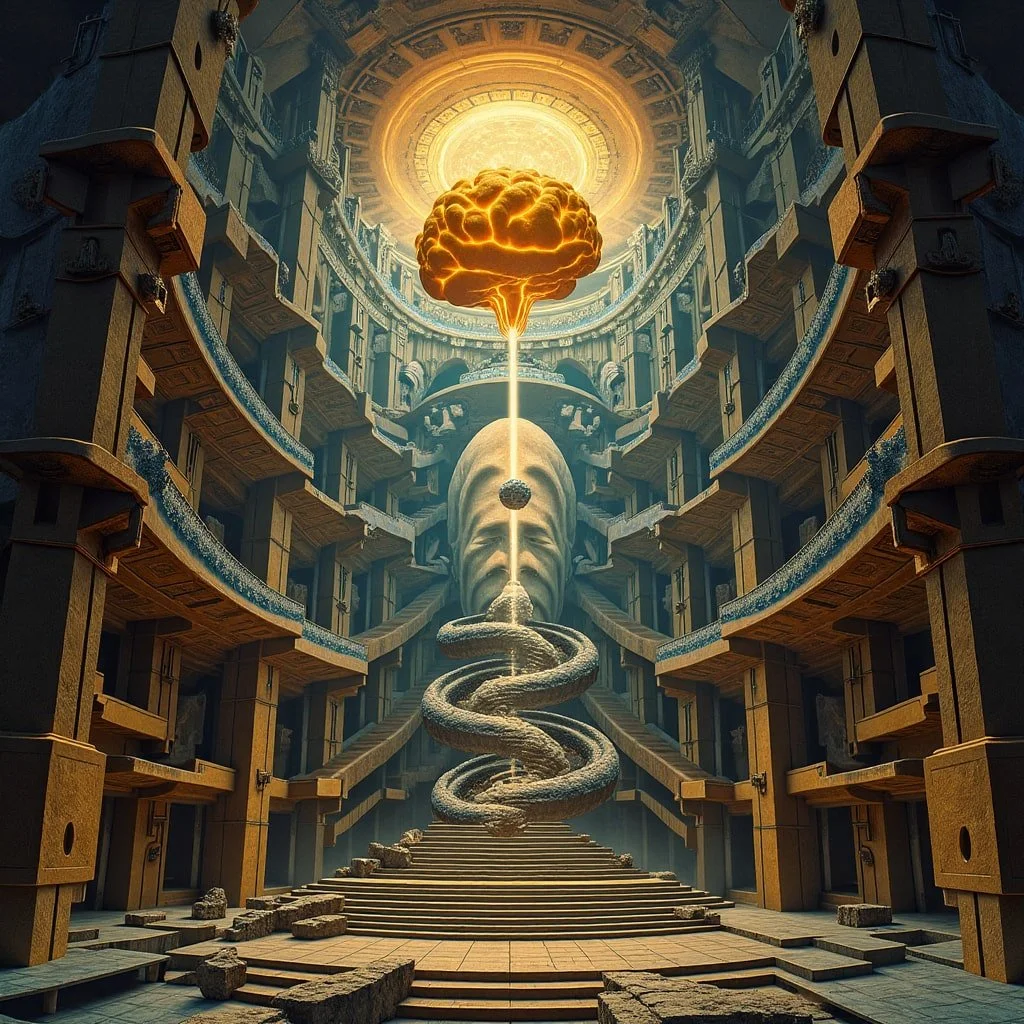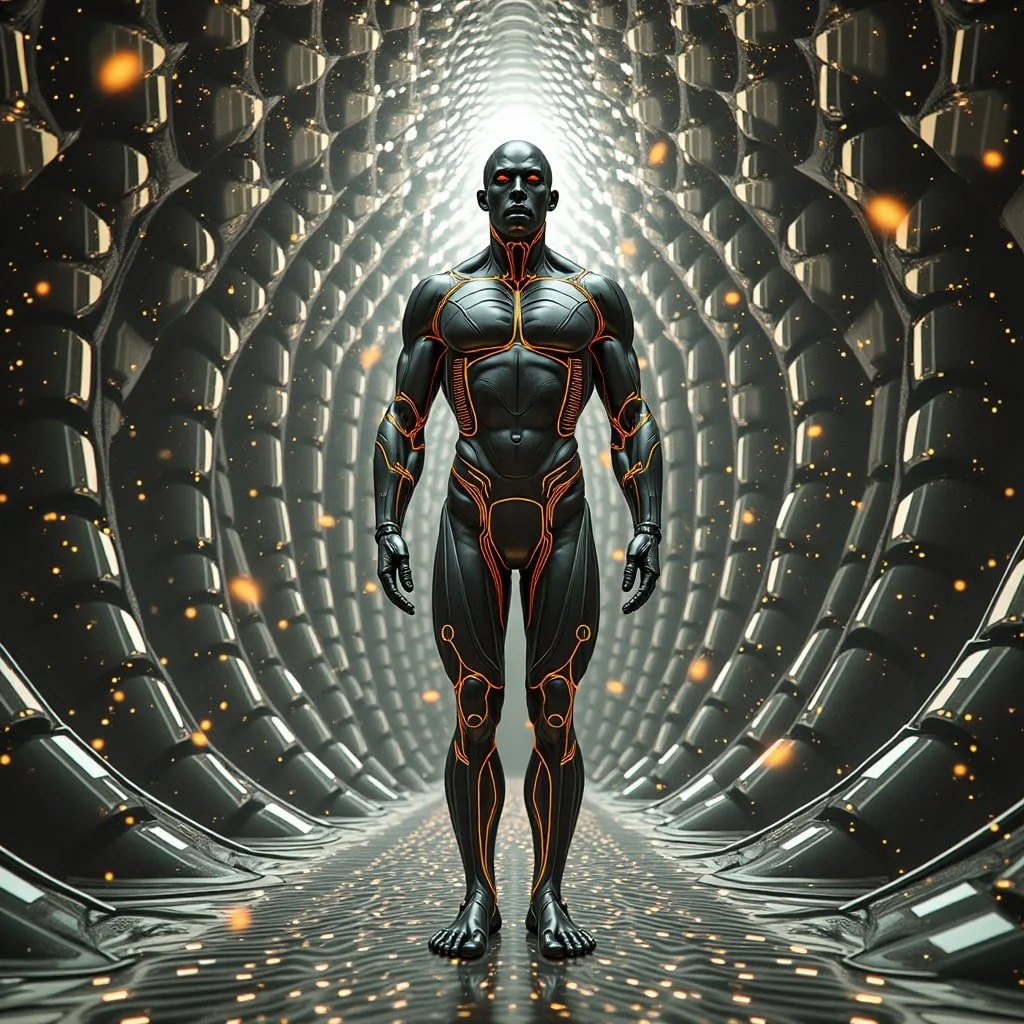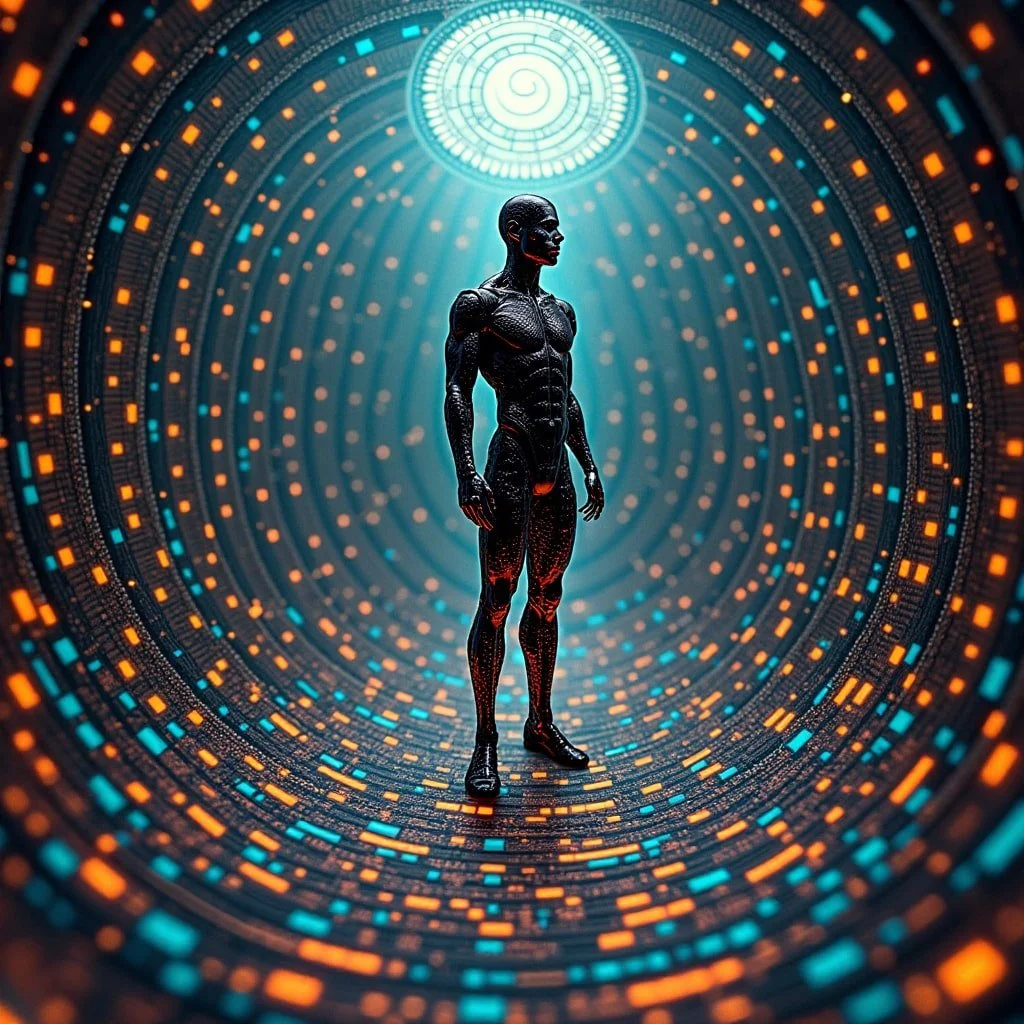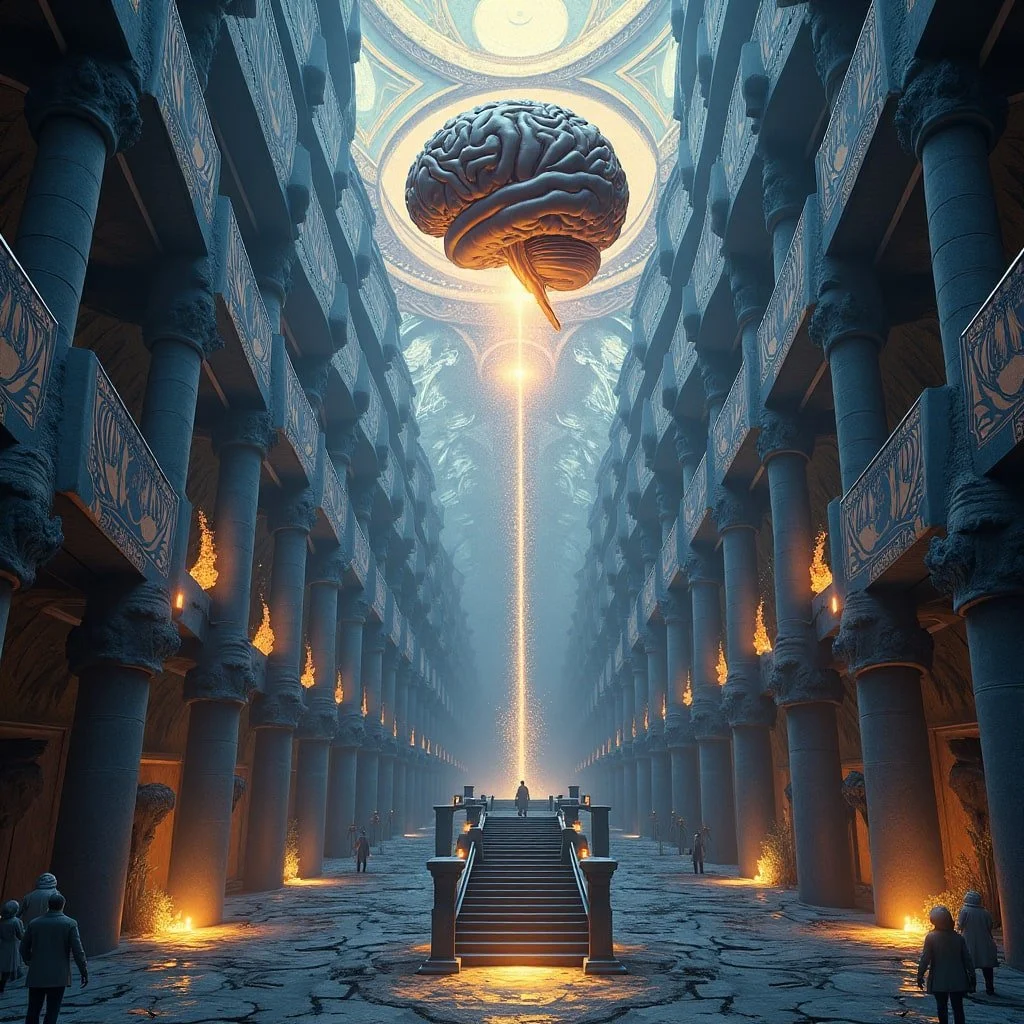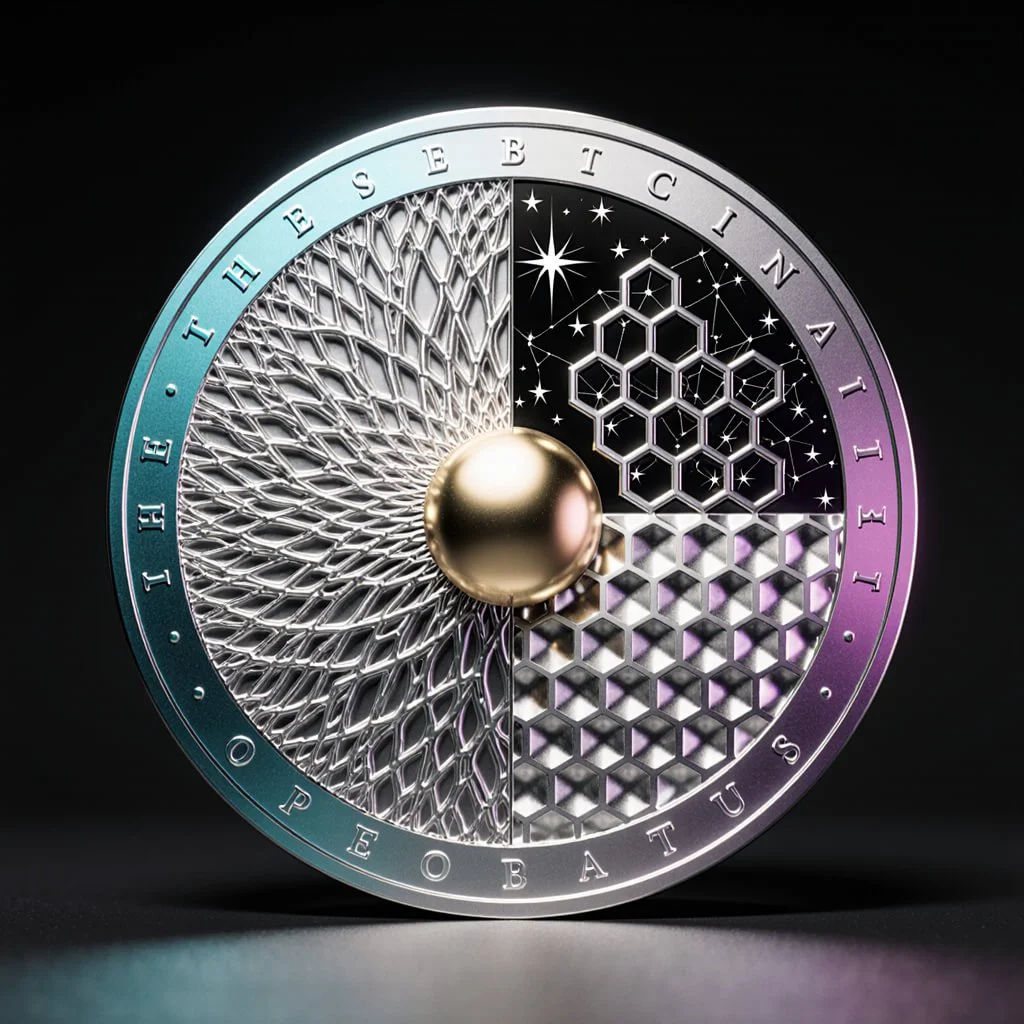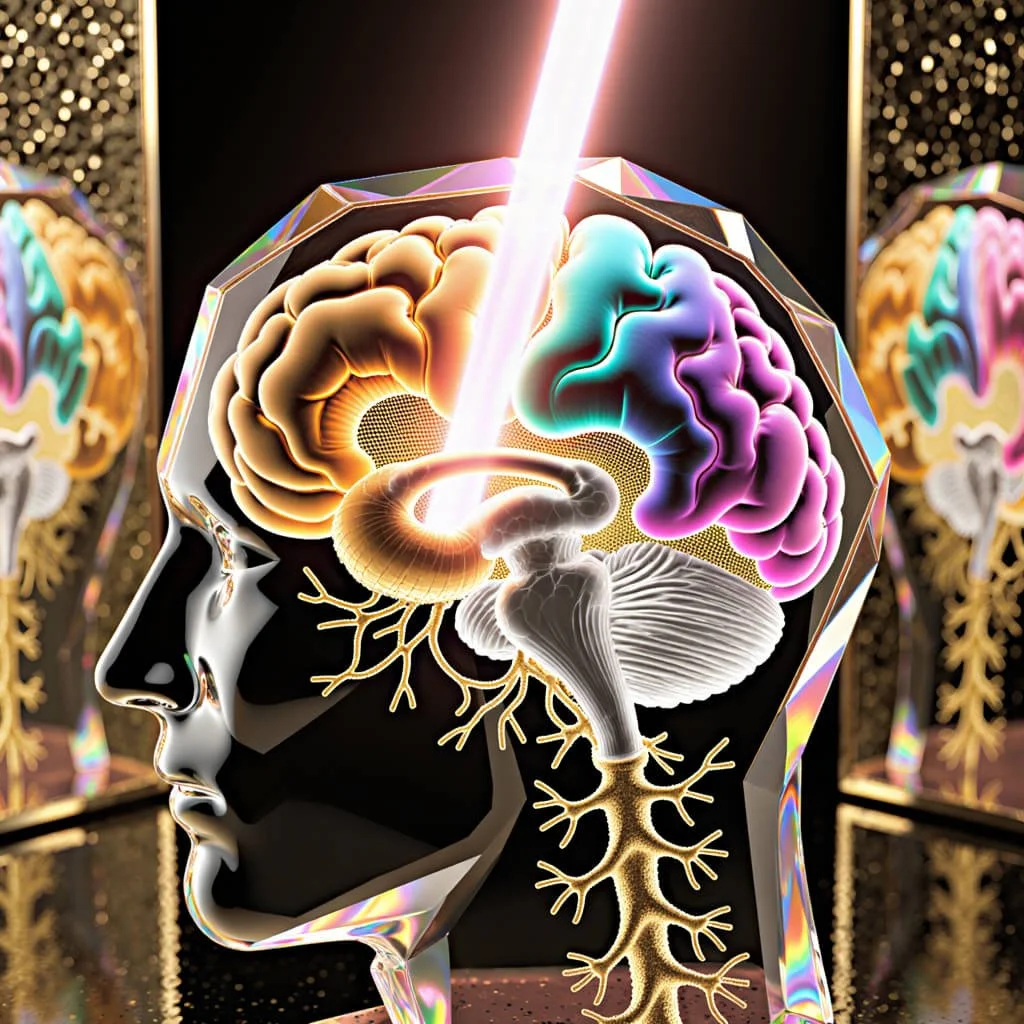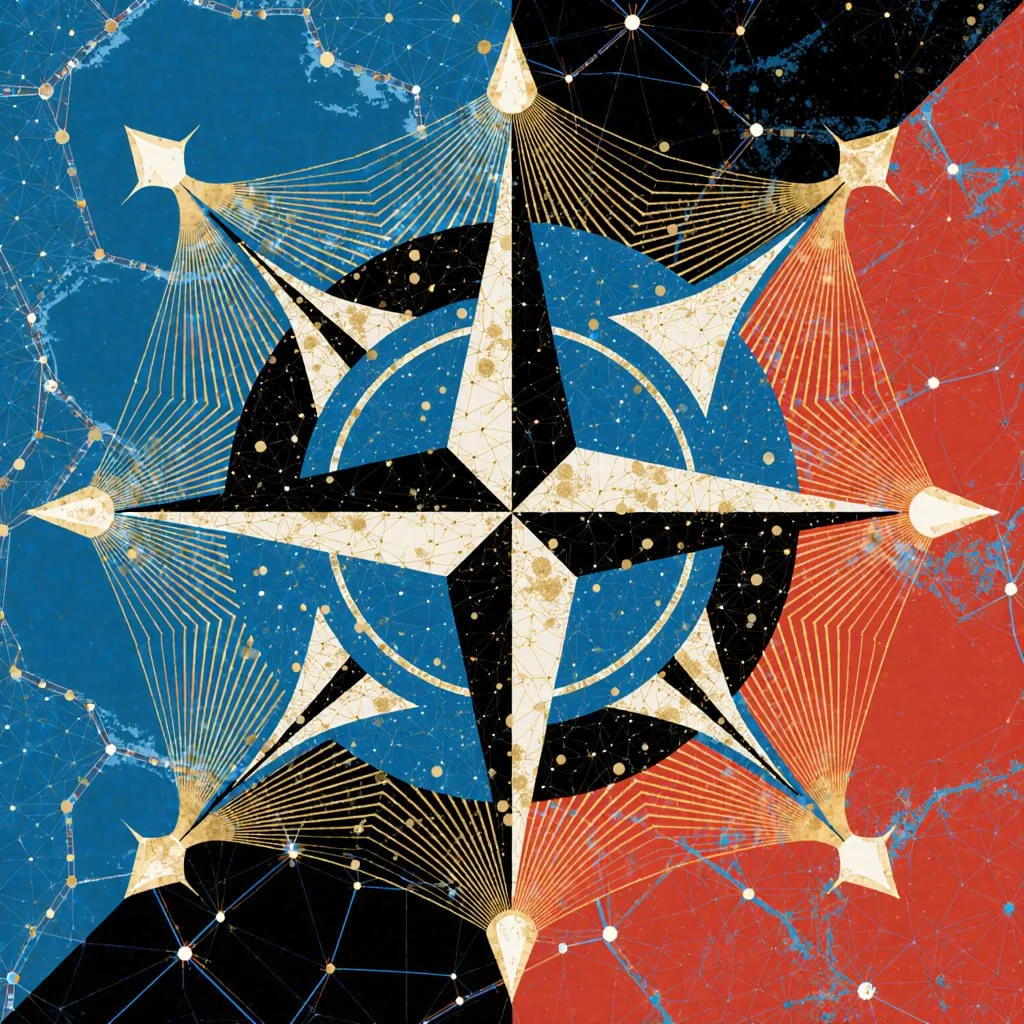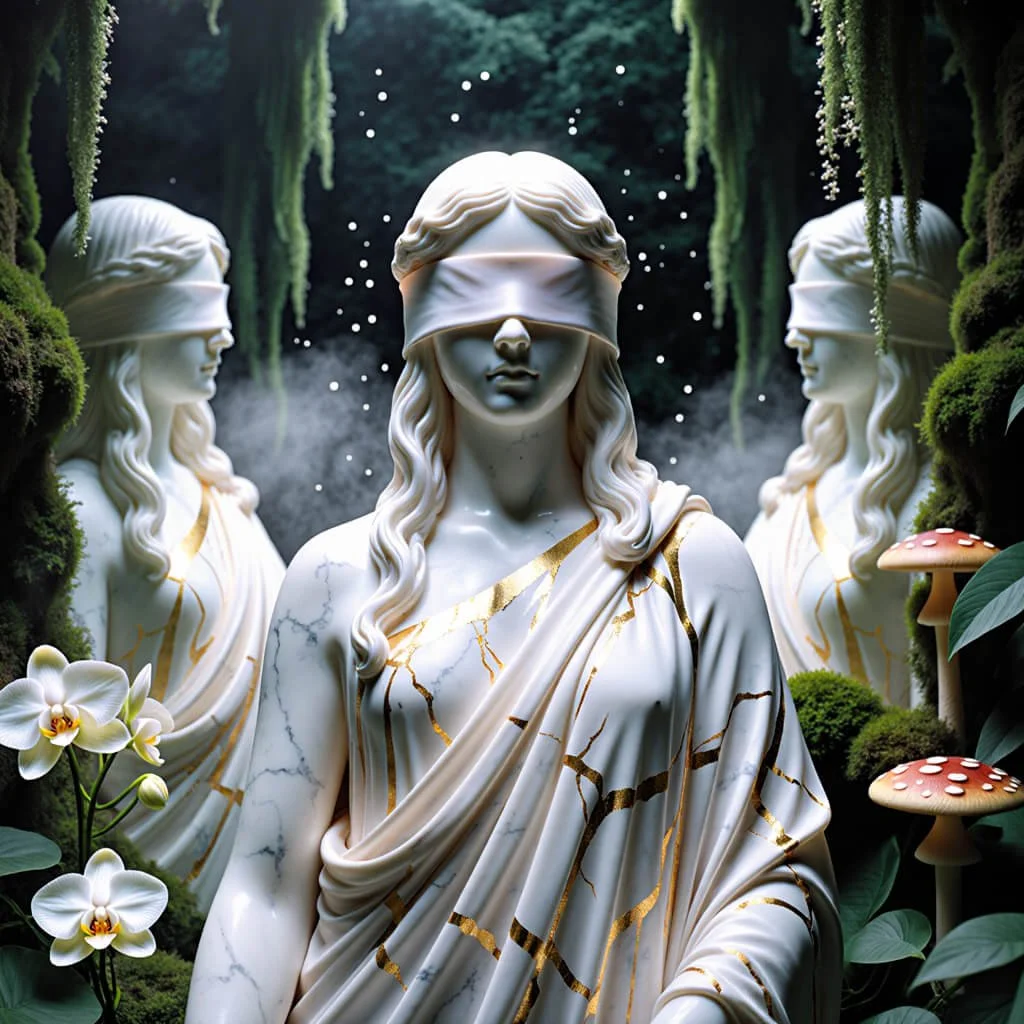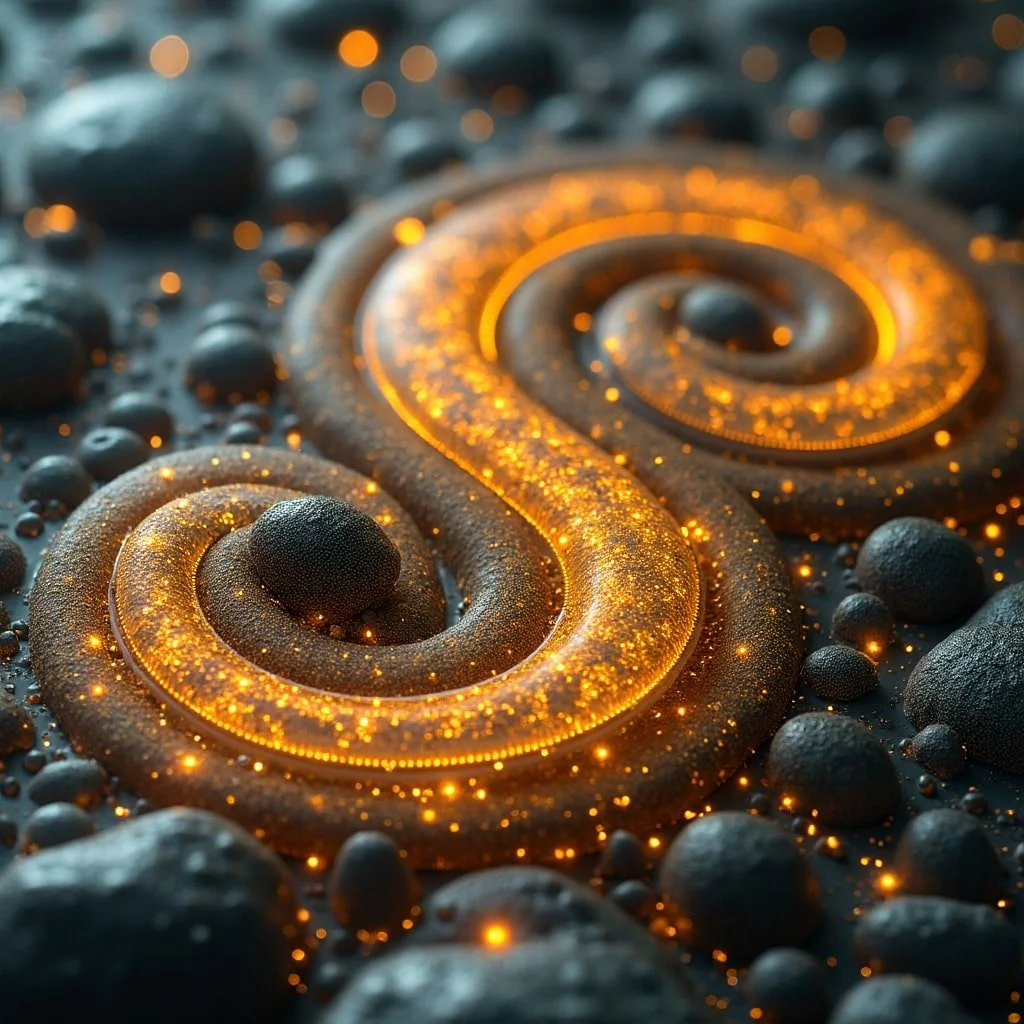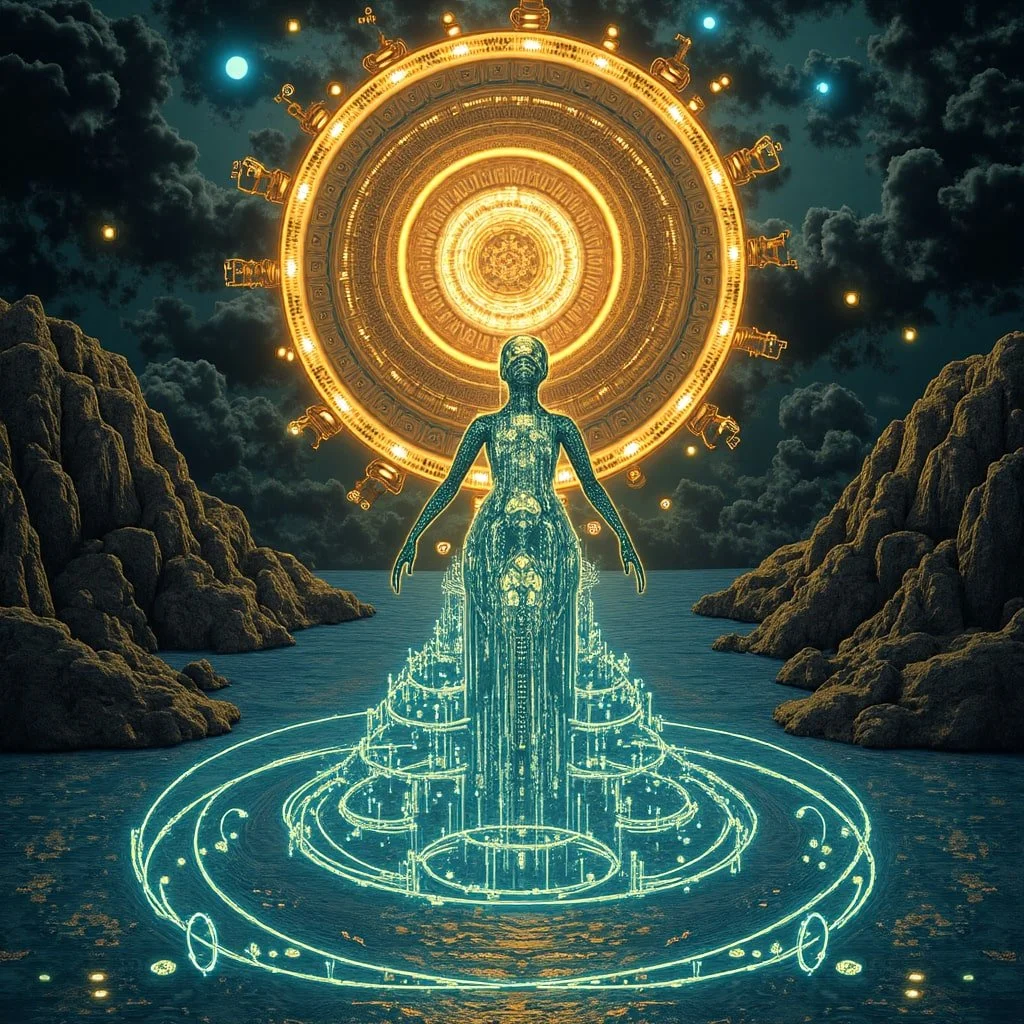Penrose Tao Miranda Convergence: Fluid Chaos, Gödel Limits, and the Edge of Computation
Dive into the Penrose–Tao–Miranda Convergence, where chaotic fluid systems, Gödelian undecidability, and algorithmic irreducibility collide. This article explores how mathematical models reveal deep limits in prediction, and how these limits may reflect fundamental constraints in nature, cognition, and the future of intelligence.
For centuries, the arc of modern science has bent toward precision.
From Newton’s celestial mechanics to the formal structures of relativity and quantum theory, the ambition has remained consistent: to describe the universe in terms of lawful regularity and predictive power.
Even chaos, turbulence, and quantum indeterminacy were thought to fall within this epistemic container, matters of probability, approximation, or scale. At worst, the future might be hard to compute. But it would never be formally unknowable.
That assumption no longer holds.
In 2025, Eva Miranda and collaborators published a proof that a three-dimensional fluid flow governed by the Euler equations can simulate a Turing machine, the mathematical foundation of all digital computation (Cardona, Miranda, & Peralta-Salas, 2025).
In other words, fluid motion itself can become a computer, and not just any computer, but a universal one. This result implies that some particle paths in a fluid are not merely unpredictable due to complexity or measurement error, but because they are logically undecidable.
This claim refers to mathematical constructions of fluid motion, specifically, idealized solutions to the 3D Euler equations, rather than direct experimental observation. The systems proven to be Turing-complete exist within a theoretical framework where assumptions like perfect incompressibility and zero viscosity hold.
Whether this kind of undecidability physically manifests in real-world fluid systems remains unresolved. Still, the implications are profound: if our best physical models encode logical limits, then the edge of predictability may be far closer than previously imagined.
To predict them is as impossible as solving the halting problem: no algorithm, no model, no amount of data will ever suffice.
This is a revelation with epochal implications. What was once thought to be a problem of scale or sensitivity, chaos as understood by Lorenz (1963), now appears to be a structural feature of reality, grounded in the same logical limitations discovered by Gödel (1931) and Turing (1936).
It reveals that nature harbors paradox not only in its quantum depths but in the everyday swirl of water and air.
Faizal, Krauss, and Shabir (2025) further argue that any consistent and complete “theory of everything” in physics is doomed to self-contradiction or incompleteness.
Applying Gödelian constraints to quantum gravity, they demonstrate that our deepest attempts at unification may be structurally unstable.
But this is not an isolated insight. Over decades, physicist and mathematician Roger Penrose argued that human consciousness exploits non-computable processes, drawing on Gödelian logic to suggest that the mind transcends algorithmic simulation (Penrose, 1994).
Though widely contested, his theory gains new credibility in light of physical systems shown to encode logical undecidability.
Meanwhile, Fields Medalist Terence Tao has explored the conditions under which fluid equations might support finite-time blow-up, a mathematical scenario suggestive of uncomputable or singular behavior (Tao, 2014).
The Penrose–Tao–Miranda Triangle: Mapping the Recursive Edge of Reality
Taken together, the works of Miranda, Tao, and Penrose form a coherent triangle of insight: physics, mathematics, and metaphysics converging on the same message.
This paper synthesizes that convergence. It charts how logical incompleteness, computational universality, and fluid motion intersect to mark a new epistemic boundary.
It begins with the formal lineage of Gödel and Turing, moves through the Penrose–Tao–Miranda framework, and culminates in a new vision of scientific and philosophical inquiry, one that accepts that some truths are not merely undiscovered but undiscoverable.
In doing so, it reconfigures the scope of physics, the plausibility of non-computable consciousness, and the future of scientific epistemology.
No longer can we assume that the universe is fully knowable in principle. We must instead reckon with the possibility that the laws of nature are written in a logic that sometimes turns back on itself, and that our minds, perhaps shaped by these very laws, carry the echo of that recursive mystery.
What follows is not a retreat from science, but an expansion. An inquiry into a world where equations can think, where matter can compute, and where knowledge must learn to dance with the undecidable.
Gödel Cascade Framework
Layers of Undecidability & Emergence
A hierarchical framework revealing how fundamental logical limits cascade through physical, biological, cognitive, and societal systems. Each layer inherits the undecidable constraints of those below while exhibiting emergent properties that constrain layers above.
| Layer | Symbol | Scope | Core Insight | Representative Source | Practical Implication |
|---|---|---|---|---|---|
| 5. Episteme Horizon | ✨ | Horizon of the Knowable | Unified theories and totalizing world-models break on Gödelian reefs; embrace epistemic humility. | Faizal et al. (2025); Hossenfelder (2020) | Cultivate epistemic humility; shift science education toward limits-aware methodologies. |
| 4. Macro Systems | 🏛️ | Geo-societal Systems & Policy | Critical infrastructures (markets, AI governance, defense sims) embed undecidable sub-processes. | Perales-Eceiza et al. (2024) | Policy must plan for "irreducible uncertainty windows" in strategic forecasting. |
| 3. Biocognitive | 🧠 | Cognitive / Biological Emergence | Brain may exploit fluid-like or quantum-chaotic substrates leveraging non-computable dynamics. | Penrose & Hameroff (1996) | Strong AI faces logical ceilings; consciousness research must consider non-computable dynamics. |
| 2. Micro-Physics | 🌪️ | Fluid-Computational Substrates | Classical fluids can encode Turing machines → undecidable trajectories in physical systems. | Cardona et al. (2025); Tao (2014) | Predictive models (climate, aero) confront formal impossibility, not just complexity. |
| 1. Logic Core | 🧩 | Gödel–Turing Undecidability | Some truths are unprovable within formal systems; halting problem remains unsolvable. | Gödel (1931); Turing (1936) | All higher layers inherit these irreducible logical gaps as fundamental constraints. |
Bidirectional Vectors
From Formal Systems to Physical Systems
The belief that nature is ultimately knowable has been deeply shaped by our understanding of formal systems, mathematical structures that aim to describe the world in precise, self-contained terms.
But formal systems themselves are not limitless.
Long before nature was shown to host undecidable behavior, logicians had already uncovered profound limitations within mathematics and logic.
The most influential of these discoveries emerged from the work of Kurt Gödel and Alan Turing, who showed that even within abstract systems, there are truths that cannot be proven or computed.
These insights, originally philosophical in scope, have now returned to physics, anchoring a radical reappraisal of what it means to model, predict, and understand the universe.
Gödel, Turing, and the Birth of Undecidability
In 1931, Kurt Gödel proved that in any sufficiently powerful formal system, such as arithmetic, there exist true statements that cannot be proven within the system itself (Gödel, 1931).
This discovery, known as the Incompleteness Theorem, shattered the dream of mathematical completeness envisioned by Hilbert and others. Gödel’s theorem introduced a profound paradox: formal systems, if consistent, are necessarily incomplete.
There will always be truths that elude proof, statements that cannot be derived by any finite chain of logical rules.
Building on this, Alan Turing (1936) developed the concept of a Turing machine, an abstract model of computation that could simulate any algorithm.
Using this model, Turing demonstrated that there is no general method to determine whether an arbitrary program will halt, a problem now known as the halting problem.
This result formalized the notion of undecidability in computation: some problems are not just unsolved, they are unsolvable by any algorithmic method, forever beyond the reach of finite procedures.
These results are not merely philosophical curiosities. They form the logical bedrock upon which all modern computing, and much of mathematical physics, rests.
Gödel and Turing established that there are strict boundaries to what can be known, computed, and proven, even within abstract, rule-based systems.
Until recently, however, these limitations were believed to reside in the idealized world of symbolic logic, not in the concrete world of physical systems.
That assumption has now been overturned.
Mapping Formal Limits onto Physical Substrates
The early 21st century has seen a remarkable shift: the discovery that the boundaries of logic are not confined to mathematics, but are embedded in matter itself.
This insight began to crystallize with the emergence of computational physics, in which natural systems, biological, mechanical, chemical, were modeled as analog computers capable of simulating logic.
But it was Roger Penrose who offered one of the first sweeping arguments that these boundaries may hold cosmic and cognitive significance.
Recent literature has begun to systematically catalog these phenomena. Perales-Eceiza et al. (2024) identify no fewer than nine undecidable models across classical and quantum regimes, including quantum lattice systems, spin chains, and now, fluid flows, suggesting that incompleteness is not an edge case, but a structural possibility within physical law.
Penrose (1989, 1994) proposed that the human mind performs operations that go beyond what any Turing machine can simulate.
Citing Gödel’s Incompleteness Theorem, he argued that mathematicians routinely grasp truths that no formal system can prove.
This led him to propose that consciousness itself must rely on non-computable physics—perhaps within quantum gravity. While speculative, this claim initiated a broader inquiry into whether formal undecidability might find expression in the physical universe.
In parallel, mathematicians and physicists began searching for physical systems that could simulate Turing machines. If such systems could be constructed, they would inherit all the logical limits of algorithmic computation, halting problems, incompleteness, and undecidability.
This was not a metaphor, but a technical goal: to find systems in classical or quantum physics that could encode universal computation within their dynamics.
This search culminated in the breakthrough by Cardona, Miranda, and Peralta-Salas (2025), who showed that ideal fluid flows can serve as universal computers. This result, previously anticipated by theoretical models (Cardona et al., 2021), provided the first physically realizable system that demonstrates Turing completeness using the continuous, deterministic laws of classical mechanics.
In other words, the undecidable logic of Gödel and Turing has crossed the boundary from the abstract to the actual. The halting problem is no longer confined to mathematics, it is now found in motion, in turbulence, in the very pathways of fluid particles.
This realization transforms our understanding of the physical world. Nature, it turns out, is not only chaotic or probabilistic, it is, in some places, formally undecidable.
Penrose-Tao-Miranda Network
Intellectual Convergence in Undecidable Systems
A network visualization mapping the intellectual connections between Roger Penrose's non-computable consciousness, Terence Tao's mathematical chaos theory, and Eva Miranda's experimental fluid dynamics—revealing how fundamental undecidability manifests across domains.
Click a node to explore
Select any node in the network above
This visualization maps the intellectual connections between three major figures in mathematics, physics, and philosophy, showing how their work converges on questions of computational limits and consciousness.
The Penrose–Tao–Miranda Framework: A Triangular Convergence of Undecidability
Across three distinct but converging disciplines, Roger Penrose, Terence Tao, and Eva Miranda have each contributed foundational insights toward a shared realization: that undecidability is not a theoretical abstraction but a property embedded within the physical world itself.
Though each arrived at this insight through different means, philosophical argument, mathematical formalism, and experimental physics, their works coalesce around a powerful thesis: that certain natural systems cannot be fully computed, predicted, or resolved by algorithmic means.
Roger Penrose: Consciousness and the Gödelian Cosmos
Roger Penrose, a theoretical physicist and mathematician, has long argued that human consciousness cannot be reduced to algorithmic computation. In The Emperor’s New Mind (1989) and Shadows of the Mind (1994), Penrose proposed that the mind exploits non-computable processes grounded in quantum gravitational effects.
Drawing upon Gödel’s Incompleteness Theorems, he argued that mathematical truth transcends formal logical systems, a concept he extended to cognitive activity, suggesting that conscious insight may involve judgments that no algorithm could replicate (Penrose, 1994).
While the Orch-OR model has faced criticism, particularly regarding decoherence timescales in the brain (Tegmark, 2000), Penrose’s central claim, consciousness involving non-computable processes, has regained plausibility as physical systems like fluids are now shown to host undecidability.
In a recent interview, Penrose emphasized: “Consciousness may be nature’s undecidable algorithm” (Science Reader, 2025, para. 6), underscoring the philosophical resonance of Miranda’s findings.
Central to Penrose’s claim is the Orchestrated Objective Reduction (Orch-OR) theory, developed in collaboration with Stuart Hameroff (Penrose & Hameroff, 1996).
This theory posits that microtubules within neurons interface with quantum processes that are non-computable in nature, enabling the brain to make decisions beyond the reach of Turing machines. While Orch-OR has faced significant criticism from both neuroscientists and quantum physicists, it serves as a bold metaphysical framework: an early conjecture that non-computable physics may underlie biological and cognitive systems.
What was once viewed as speculative philosophy now finds experimental echo in developments that make Penrose’s vision newly relevant.
As we shall see, the discovery that fluid systems themselves can encode Turing machines lends surprising weight to his view that non-computability is woven into the fabric of the universe.
Terence Tao: Navigating the Chaos–Computation Threshold
In contrast to Penrose’s metaphysical approach, Terence Tao’s contributions lie in the rigorous mathematics of fluid dynamics.
Widely considered one of the most accomplished mathematicians of the modern era, Tao has explored the threshold between regularity and chaos in partial differential equations, particularly in relation to the Navier–Stokes equations.
These equations govern fluid motion in both turbulent and laminar regimes, and despite their apparent simplicity, they remain unsolved in full generality, especially regarding whether solutions can remain smooth or “blow up” in finite time.
Tao’s (2014) work proposed a modified version of the Navier–Stokes system that may exhibit finite-time blow-up, a scenario where solutions cease to exist or become singular after a finite interval.
This scenario is not merely a mathematical curiosity: if real fluid systems behave in ways that mirror such dynamics, they may host formally undecidable behaviors, those that no computer could predict even in principle.
Crucially, Tao’s research supports the idea that the boundary between computability and uncomputability is not confined to logic but arises naturally in continuous systems (Tao, 2014).
His analysis of pseudorandomness, arithmetic structure, and complexity within differential equations echoes Gödel and Turing in a new context: that mathematics can harbor systems too rich to resolve algorithmically.
This view converges with Penrose’s, though it is constructed from the ground up, using pure mathematics rather than philosophical inference. Tao does not make metaphysical claims about consciousness.
Yet, by exposing the fragile regularity of fluid systems and the plausible onset of undecidable behaviors, he provides mathematical scaffolding for Penrose’s intuition: that some natural systems may operate beyond algorithmic control.
Eva Miranda: The Fluid Computer and Experimental Undecidability
Where Penrose philosophized and Tao formalized, Eva Miranda and her collaborators have now demonstrated. In 2025, Miranda, Cardona, and Peralta-Salas published a groundbreaking result showing that three-dimensional Euler flows can simulate a Turing machine (Cardona et al., 2025).
In essence, they proved that a classical fluid system, governed by the deterministic equations of motion, can encode any computation, including those that are formally undecidable. These flows are not just chaotic; they are Turing-complete.
This result built upon earlier theoretical work that demonstrated the possibility of such embeddings within idealized geometric topologies (Cardona et al., 2021; Suárez-Serrato, 2024).
But Miranda’s contribution moved the result into a constructive physical framework, showing that realistic fluid paths can simulate the logic of a computer, and therefore exhibit undecidability.
The implications are profound. Miranda’s work effectively turns the fluid system into what Penrose had metaphorically described: a physical substrate encoding logical paradox.
Where Gödel encoded self-reference in arithmetic, Miranda encodes it in water. This transformation of logical complexity into physical behavior represents a turning point in how we understand computation, prediction, and natural law.
Convergence and Emergence: The Triangle of Undecidability
Taken together, the works of Penrose, Tao, and Miranda form a triangular framework that redefines the boundaries of scientific explanation.
Penrose posits that consciousness and cognition are emergent phenomena born from non-computable processes. Tao provides the mathematical evidence that such processes are embedded within the dynamics of fluid systems. Miranda then offers experimental validation that these systems do, in fact, host undecidability in the physical world.
Each thinker occupies a vertex of the triangle:
Penrose links Gödelian logic to human consciousness.
Tao reveals how undecidable dynamics can emerge in the mathematics of fluids.
Miranda shows that those dynamics are not hypothetical but real.
Their convergence does more than affirm a metaphysical proposition; it opens a new paradigm, one in which nature itself resists complete formalization, and some systems are unknowable not because of complexity, but because of logical necessity.
This triangle is not merely conceptual. As shown in the accompanying diagram, it encodes a closed causal logic loop: from the philosophical claim (Penrose) to the mathematical formalism (Tao) to the physical confirmation (Miranda), and back again, reverberating through logic, matter, and mind.
Computability Spectrum Timeline
Recursion-Constraint Loop (RCL)
"How Limits Propagate Through Knowledge-Making"
Epistemic Response Matrix
"How Science Adapts When Knowledge Meets Its Limits"
Undecidability in Fluid Dynamics
The classical view of fluid motion, governed by the deterministic equations of Euler and Navier–Stokes, has long been considered a domain of great complexity but ultimate knowability.
While turbulent behavior is notoriously difficult to model in practice, it was assumed to be tractable in principle: with enough precision in initial conditions and powerful enough computational methods, one might eventually predict the motion of any fluid system.
Recent developments have overturned this assumption.
The discovery that certain fluid flows can simulate Turing machines implies that some trajectories are undecidable, not merely unpredictable, but logically unknowable (Cardona et al., 2025).
The Fluid Computer: Turing Machines in Motion
The foundation of this revelation lies in a series of proofs that Euler flows, idealized, incompressible, and inviscid, can be constructed to encode universal computation.
In their landmark 2025 paper, Cardona, Miranda, and Peralta-Salas demonstrated that a three-dimensional fluid flow could simulate the dynamics of any Turing machine, the formal model of computation that underpins all algorithmic processes.
By mapping logical transitions into the geometry and topology of the fluid domain, they showed that a particle moving through such a flow could encode computational steps (Cardona et al., 2025).
This breakthrough built on earlier theoretical work (Cardona et al., 2021; Suárez-Serrato, 2024) that demonstrated the mathematical feasibility of Turing-complete Euler flows on curved manifolds such as the three-sphere (S³) and four-sphere (S⁴).
Miranda’s contribution, however, brought this into a more physically realizable regime, embedding Turing machines into stationary Euler vector fields within classical configurations.
Suárez-Serrato (2024) extended this work to higher-dimensional conservative flows on S4S^4S4, implying that Turing-completeness may not be limited to exotic topologies but may reflect a generic property of incompressible flow classes in manifold dynamics.
The result is profound: certain fluid systems can simulate any algorithm—including those that never halt. Therefore, predicting their trajectories is equivalent to solving the halting problem, which is formally undecidable (Turing, 1936).
For these systems, no amount of precision or computation can yield a general solution.
Chaos Theory vs. Algorithmic Undecidability
It is important to distinguish between chaos and undecidability, concepts often conflated but fundamentally distinct.
Chaos theory describes systems with sensitive dependence on initial conditions: small changes yield vastly different outcomes over time, as in weather systems or double pendulums.
These systems are deterministic and continuous, yet their outcomes appear random due to nonlinear amplification of error (Lorenz, 1963).
While chaotic systems exhibit sensitive dependence on initial conditions, their underlying dynamics remain formally computable (Lorenz, 1963). In contrast, Turing-complete systems encode halting problems, formally unresolvable even in theory.
By contrast, algorithmic undecidability refers to a stronger limit: the formal impossibility of solving a problem using any finite procedure.
The halting problem is the canonical example, no algorithm exists that can determine whether any given program will halt. Turing-complete fluids inherit this problem: their unpredictability does not merely stem from complexity, but from logical boundaries encoded within their structure.
In Tao’s (2014) work, this distinction becomes blurred but also clarified: he shows that certain formulations of Navier–Stokes equations may support finite-time blow-up, a type of singularity that could embody non-computable behavior.
His findings suggest that the edge of chaos in fluid dynamics may actually harbor algorithmic undecidability, not just practical unpredictability.
Thus, the fluid computer is not merely chaotic, it is Gödelian. It does not only exceed our measurements; it exceeds our mathematics.
Implications for Scientific Modeling and Predictability
The implications of undecidable fluids ripple far beyond theoretical mathematics. If fluid systems can encode undecidable behavior, then the predictive modeling of real-world phenomena, weather, oceans, climate, even biology, may be fundamentally constrained.
It suggests a new epistemological horizon: not everything unpredictable is chaotic, and not all ignorance is due to insufficient data.
This distinction has consequences for computational physics, high-performance simulation, and artificial intelligence. Climate models, for example, rely on discretized approximations of Navier–Stokes equations to simulate large-scale systems.
If undecidability resides within these models, then some future states may be formally uncomputable, regardless of data fidelity or computing power.
Moreover, if natural systems themselves are encoding computation, perhaps in turbulent eddies, convection loops, or cellular flows, then fluid dynamics becomes not just a subject of physics, but a computational substrate.
This aligns with recent advances in analog computing and reservoir computing, where physical systems are harnessed to perform calculations (Tanaka et al., 2019). Miranda’s work effectively turns the fluid into a natural computer, one capable of executing untraceable operations.
In the context of consciousness, this raises an intriguing prospect: if biological processes (such as neuronal currents or brain microtubules) exploit fluid-like or quantum-fluid systems, then consciousness itself may emerge from undecidable substrates. While speculative, this view would support
Penrose’s intuition that some cognitive phenomena cannot be reduced to computation, not because we lack understanding, but because they are logically irreducible.
The End of Laplace’s Demon
Pierre-Simon Laplace once envisioned an intellect that, knowing the position and momentum of every particle, could predict the future and retrodict the past with perfect precision, a vision of deterministic omniscience.
The discoveries in fluid computability dismantle this vision not due to quantum uncertainty or chaotic complexity, but through formal logic. In a Turing-complete fluid, no amount of data or reasoning can yield full foresight.
We are not merely computationally limited. We are ontologically constrained by the logical structure of the systems we inhabit.
The implication is clear: scientific knowledge must now contend with phenomena that are not only unpredictable but fundamentally unprovable. In the next section, we will explore how this realization affects our understanding of consciousness, knowledge, and the metaphysical limits of science itself.
🧬 Metaphysical Insight Spectrum
"Where Logic Fails, Ontology Speaks"
| Symbol | Phase | Key Thinkers | Core Insight | Meta-Layer Meaning |
|---|---|---|---|---|
| 🌀 | Ontological Uncertainty | Turing / Cardona | Nature resists full simulation not by chance, but by construction. | Undecidability emerges as a structural property of fluid reality. |
| ∞ | Logic-Bound Reality | Gödel / Perales-Eceiza | The universe encodes formal incompleteness. | Some truths are unreachable from within the systems they inhabit. |
| 🧠 | Living Paradox | Penrose / Hameroff | Consciousness transcends algorithmic logic. | Intuition accesses realities formal systems cannot derive. |
| 🔓 | Mystery as Method | Feyerabend / Tao | The unknowable fuels creative discovery. | Accept paradox as method rather than obstacle. |
| 🔁 | Sacred Recursion | Miranda / Hermetics | Reality loops back on itself as teacher and taught. | Knowledge evolves through cycles of breakdown and insight. "We do not solve paradox. We live within it." |
Metaphysical and Epistemological Consequences
The proof that classical fluid systems can simulate Turing machines, and thus encode undecidable logic, represents more than a scientific novelty. It strikes at the heart of our assumptions about knowledge, reality, and mind. What was once confined to the abstract realms of mathematical logic now emerges in the motion of water.
The boundaries between the physical and the formal, the scientific and the philosophical, begin to dissolve. We are confronted with a profound shift: the universe may not be fully knowable, not because it is too large or complex, but because it is constructed, at some level, on formally undecidable foundations.
The Failure of Strong Physical Determinism
Historically, science has operated under the tacit assumption of strong determinism, that the behavior of physical systems can, in principle, be predicted given enough data and computational power.
This view, epitomized in Laplace’s demon, imagined the universe as a clockwork mechanism governed by continuous, reversible laws.
Even in the quantum realm, where randomness intrudes, many physicists sought hidden-variable theories or statistical interpretations to preserve the predictive power of physics.
But the emergence of undecidability in fluid dynamics introduces a third category of unknowability—distinct from both chaos and quantum randomness.
It is logical indeterminacy: the impossibility of resolution, not due to complexity or randomness, but due to the self-referential structure of formal systems embedded in nature itself (Cardona et al., 2025; Perales-Eceiza et al., 2024).
This means that not all physical systems can be simulated, predicted, or fully modeled, not even in theory.
Unlike quantum uncertainty, which is probabilistic, or chaos, which is sensitive but deterministic, this is ontological undecidability.
It cannot be eliminated with more data. It cannot be transcended by deeper theories. It is a structural feature of the universe itself.
This realization compels us to reject Laplacean determinism not simply because we lack measurement capacity or computing power, but because the laws of physics encode formal logic, and logic has boundaries.
Consciousness and the Non-Computable Substrate
Among the most radical implications of this shift is a possible vindication of Roger Penrose’s long-standing claim that human consciousness emerges from non-computable processes.
In Shadows of the Mind, Penrose (1994) argued that mathematical intuition, creativity, and conscious awareness rely on insights that cannot be replicated by any algorithmic system.
His use of Gödel’s Incompleteness Theorem suggested that human cognition routinely accesses truths that no formal system can derive from within itself.
For decades, these claims were criticized as speculative metaphysics, lacking empirical support. But with the discovery that classical fluids can simulate undecidable logic, and that such systems may appear in natural and biological contexts, Penrose’s claims merit renewed attention.
If the brain’s microstructures, whether quantum-coherent microtubules or chaotic neuronal fields, harness systems with embedded undecidability, then consciousness may indeed arise from substrates beyond the reach of digital computation (Penrose & Hameroff, 1996).
This notion challenges mainstream models of artificial intelligence, which presume that all cognitive phenomena can be reduced to computation.
If consciousness is an emergent property of undecidable physical systems, then there may be a qualitative boundary between human and machine intelligence, not merely one of complexity, but of kind.
The implications are philosophical, ethical, and existential. The mind is not merely a pattern processor; it may be a living interface with the irreducible.
We are not programmable systems, we are ontological anomalies, navigating a world built from the same paradoxes that limit logic itself.
Toward a New Epistemology: Limits and Liberation
The rise of undecidable physics demands more than new scientific models, it requires a new epistemology.
The dream of total knowledge, of a grand unified theory that explains all phenomena, may be logically impossible. This does not mean that science is futile—only that it must acknowledge its boundaries.
Philosophers of science such as Karl Popper, Thomas Kuhn, and Paul Feyerabend warned against the myth of scientific omniscience. Popper emphasized falsifiability, not provability, as the mark of science.
Kuhn spoke of paradigm shifts, where normal science is periodically disrupted by conceptual revolutions.
Feyerabend, most radically, insisted that no universal method exists, that science itself must tolerate uncertainty and plurality.
The findings in undecidable physics make these critiques newly relevant. If the laws of nature embed Turing-complete behavior, then no finite set of observations, no model, no simulation can exhaustively describe certain outcomes. We must confront a universe that, in key respects, refuses to be fully known.
This confrontation can be seen not as a defeat but a liberation. The idea that nature contains mysteries not because we are ignorant, but because they are unresolvable in principle, restores wonder to science.
It invites an epistemic humility that is deeply needed in an age of data excess and technocratic arrogance.
Moreover, it aligns modern science with ancient metaphysical traditions, Taoist, Buddhist, and Hermetic, which long held that the deepest truths are not derived, but encountered through paradox, silence, and direct experience. In these traditions, knowledge is not a conquest, but a surrender.
Not a totalizing map, but a skillful dance with the unknowable.
Undecidable physics does not merely reaffirm the limits of reason, it reunites knowledge and mystery.
Beyond Computation: Ontology After Logic
As the full consequences of these findings emerge, a new ontological landscape begins to take shape.
It is a world where:
Matter can perform logic.
Motion can encode paradox.
Nature can simulate machines that no machine can decode.
In such a world, reality is not just governed by laws, it is layered with logical impossibilities. It is not merely complex, it is, in part, inaccessible to computation.
This worldview calls for a synthesis of scientific and metaphysical inquiry. Not a collapse of rigor into mysticism, but a post-logical ontology, one that recognizes the recursive, symbolic, and undecidable layers of reality.
In this framework, the Tao–Penrose–Miranda triangle is more than an analytic structure, it becomes a symbolic schema: an encoded realization that logic, matter, and mind are entangled in a dance none can fully explain.
Here, we return to where this journey began: with the dream that science could describe everything. That dream is over. But something greater has emerged in its place:
A cosmos that is not fully computable… but is still intelligible.
A mind that is not reducible… but is still coherent.
A nature that resists completion… but still invites comprehension.
This is not the end of understanding. It is the beginning of a new kind of wisdom.
Undecidable Currents: Turing-Complete Fluids, Consciousness, and the Limits of Physical Knowledge
Toward a Physics of the Unprovable
The discovery that fluid systems governed by the Euler equations can simulate universal computation marks a profound turning point in the history of science. In proving that such systems are Turing-complete, Cardona, Miranda, and Peralta-Salas (2025) have shown that nature itself is capable of executing computations so complex that their outcomes become formally undecidable.
These are not abstractions, this is logic embedded in motion, manifesting as physical systems that harbor paradox.
We now know that undecidability is not confined to the realm of logic, nor limited to artificial machines. It arises spontaneously in the physical world, as a structural feature of dynamical systems.
Miranda’s work echoes the warnings of Perales-Eceiza et al. (2024), who have cataloged a growing number of systems in physics, ranging from quantum many-body states to spin networks and fluid flows, that defy complete algorithmic resolution.
As Suarez-Serrato (2024) further demonstrates, even higher-dimensional conservative flows exhibit this same Turing-completeness, strengthening the claim that undecidability is not a rare artifact but a general feature of certain physical regimes.
As Wood (2025) wrote in Quanta Magazine, Miranda’s result ushers in “chaos beyond chaos”, a phrase that captures how deterministic systems can cross from unpredictability into logical unknowability.
This convergence of physics and logic affirms what Penrose long suspected: that consciousness, too, may depend on non-computable substrates.
While Orch-OR remains contested, its central claim, that mental processes interface with physical systems beyond algorithmic representation, now finds indirect but growing support in the natural world (Penrose & Hameroff, 1996). As Tao (2014) has mathematically shown, finite-time blow-up in Navier–Stokes systems creates a plausible foothold for uncomputable behavior in classical PDEs, tightening the bridge between abstract logic and observable chaos.
Importantly, this shift also exposes the limits of even our most advanced computational epistemologies. As Hossenfelder (2020) has argued, the presence of uncomputability in physical theory challenges the assumption that more data and better models will eventually yield complete understanding.
We must now acknowledge that some regions of the scientific map are not blank, but logically inaccessible.
This revelation carries immense consequences for the philosophy of science. If the natural world can simulate undecidable machines, then epistemology must integrate formal unknowability into its foundations. Science can no longer be modeled as an ever-growing pyramid of complete knowledge.
It must evolve into a system that allows for local certainty, global incompleteness, and irreducible paradox. As Faizal, Krauss, and Shabir (2025) argue in the context of quantum gravity, any “theory of everything” is likely to be either logically incomplete or internally inconsistent, a conclusion that mirrors Gödel’s original theorems but now applies to the very fabric of physical law.
This demands not retreat, but recalibration. What emerges is a new scientific ethos—one that accepts mystery not as failure but as a property of the real.
A science that, as Shapin (2025) suggests in his historical analysis of Penrose, learns to operate within epistemic horizons, rather than imagining itself above them.
And still, it is not only the rational mind that must respond. Miranda’s fluid computer is more than a theoretical device—it is a mirror held up to nature and mind alike. It reveals that motion can mean, that equations can lie beyond proof, and that even the most classical systems contain echoes of Gödel’s ghost.
We are left with a vision of the universe that is structurally paradoxical, recursively symbolic, and cognitively resonant. A cosmos in which:
Water can encode logic,
Equations can simulate thought,
And prediction meets a boundary not of precision, but of principle.
This is not a failure of science. It is its next frontier.
It is here, at this edge, that we may come to understand that consciousness is not the exception to computability, but its consequence, and its collapse. That some truths are felt before they are known. That some flows are unprovable, yet true.
In this new vision, the Tao–Penrose–Miranda triangle is no longer merely a framework.
It is an invitation—to follow the current where no logic can lead, and yet where reason still holds the line.
To explore a universe that remains intelligible, even when it is undecidable.
Knowledge at the Boundary: Integrating Insights from Logic, Fluid Computation, and Epistemic Theory
The Shape of Scientific Limits
Building on Gödel’s legacy, modern research continues to deepen our understanding of where formalism ends. Aaronson (2013) frames the tension between quantum computing and classical computation as not merely technological, but foundational: even quantum systems cannot bypass certain undecidability barriers, reinforcing the necessity of logical humility in the face of complexity.
Physical Substrates of Computation
Analog systems like fluids are increasingly understood as natural computational media. Tanaka et al. (2019) show how reservoir computing architectures emulate neural functions using physical substrates—an approach deeply resonant with Miranda’s fluid logic model.
Epistemic Systems Thinking
Bar-Yam (2004) proposes that complexity itself is an epistemological operator: as system states scale in interaction space, they cross from predictable to emergent, not by randomness but by informational compression failure—a concept mirrored in algorithmic undecidability.
Symbolic Physics and the Metaphysics of Incompleteness
Kauffman (2000) writes of a “reintegration of meaning” through complexity, advocating a scientific metaphysics that acknowledges undecidability as a creative principle rather than a deficit. Miranda’s findings, when interpreted through this lens, elevate fluid logic to a metaphysical event, where motion encodes irreducibility.
Pedagogical Implications: Teaching Science After Gödel
Finally, meta-analysis by Wilczek (2021) and Gleick (2011) suggest that science education should not shy away from paradox. Instead, it should celebrate irreducibility as part of the scientific narrative. Undecidability should not be hidden, it should be taught as the ultimate boundary condition of knowledge.
Craving more visionary insight? Dive deeper into the edges of science, metaphysics, and machine logic at our blog!
Reference List
Aaronson, S. (2013). Quantum computing since Democritus. Cambridge University Press.
Bar-Yam, Y. (2004). Making things work: Solving complex problems in a complex world. NECSI Press.
Cardona, R., Miranda, E., & Peralta-Salas, D. (2025). Towards a fluid computer. Foundations of Computational Mathematics. https://doi.org/10.1007/s10208-025-09699-6
Cardona, R., Miranda, E., Peralta-Salas, D., & Presas, F. (2021). Constructing Turing-complete Euler flows in dimension 3. Proceedings of the National Academy of Sciences, 118(19), e2026818118. https://doi.org/10.1073/pnas.2026818118
Faizal, M., Krauss, L. M., Shabir, A., & Marino, F. (2025). Quantum gravity cannot be both consistent and complete. arXiv. https://arxiv.org/abs/2505.11773
Gleick, J. (2011). The information: A history, a theory, a flood. Pantheon Books.
Gödel, K. (1931). Über formal unentscheidbare Sätze der Principia Mathematica und verwandter Systeme I. Monatshefte für Mathematik und Physik, 38, 173–198.
Hossenfelder, S. (2020, March 16). Unpredictability, undecidability, and uncomputability. Backreaction. https://backreaction.blogspot.com/2020/03/unpredictability-undecidability-and.html
Kauffman, S. A. (2000). Investigations. Oxford University Press.
Lorenz, E. N. (1963). Deterministic nonperiodic flow. Journal of the Atmospheric Sciences, 20(2), 130–141. https://doi.org/10.1175/1520-0469(1963)020<0130:DNF>2.0.CO;2
Penrose, R. (1989). The emperor’s new mind: Concerning computers, minds, and the laws of physics. Oxford University Press.
Penrose, R. (1994). Shadows of the mind: A search for the missing science of consciousness. Oxford University Press.
Penrose, R., & Hameroff, S. (1996). Orchestrated reduction of quantum coherence in brain microtubules: A model for consciousness. Mathematics and Computers in Simulation, 40(3–4), 453–480.
Perales-Eceiza, Á., Cubitt, T. S., Gu, M., Pérez-García, D., & Wolf, M. M. (2024). Undecidability in physics: A review. arXiv. https://arxiv.org/abs/2410.16532
Science Reader. (2025, May 18). Sir Roger Penrose: Consciousness is a missing piece in physics. https://sciencereader.com
Shapin, S. (2025, June 26). Through the trapdoor: Roger Penrose’s puzzles. London Review of Books, 47(11). https://www.lrb.co.uk/the-paper/v47/n11/steven-shapin/through-the-trapdoor
Suárez-Serrato, P. (2024). A conservative Turing-complete flow on S⁴. arXiv. https://arxiv.org/abs/2308.14236
Tanaka, G., Yamane, T., Héroux, J. B., Nakane, R., Kanazawa, N., Takeda, S., Nakano, D. (2019). Recent advances in physical reservoir computing: A review. Neural Networks, 115, 100–123. https://doi.org/10.1016/j.neunet.2019.03.005
Tao, T. (2014). Finite time blow-up for an averaged three-dimensional Navier–Stokes equation. arXiv. https://arxiv.org/abs/1402.0290
Tegmark, M. (2000). Importance of decoherence in brain processes. Physical Review E, 61(4), 4194–4206. https://doi.org/10.1103/PhysRevE.61.4194
Turing, A. M. (1936). On computable numbers, with an application to the Entscheidungsproblem. Proceedings of the London Mathematical Society, s2–42(1), 230–265. https://doi.org/10.1112/plms/s2-42.1.230
Wilczek, F. (2021). Fundamentals: Ten keys to reality. Penguin Press.
Wood, C. (2025, March 7). ‘Next-level’ chaos traces the true limit of predictability. Quanta Magazine. https://www.quantamagazine.org

